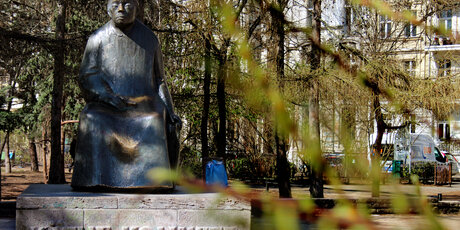Kollwitzplatz
This colourful place was built during the years of rapid industrial expansion in Germany (1870-1873), with its circular flower bed which is known as one of the most beautiful places in Berlin. Kollwitzplatz and Kollwitzstrasse received their names in 1947 honouring the graphic artist and painter Käthe Kollwitz (1867-1945).
From 1875 onward the place had the name Wörther Platz after the city Wörth was conquered in the Franco-German War of 1870/71. The Wörther Platz and the adjacent streets were called the Alsace-Lorraine quarter. The place received its present look in 1887 after plans of the City Garden director Hermann Mächtig (1837-1909). Many officers from the neighbouring barracks near the Alexander Platz had their officer’s quarters there. That is why the people called it then "Quarter of Generals". Käthe Kollwitz lived and worked in the Weißenburger Strasse 25 (today Käthe-Kollwitz-Strasse 56a), together with her husband Dr. Karl Kollwitz (1863-1945) well known as the doctor of the poor. Their house was destroyed during the war in 1943. In 1950 the place was remodelled after designs of the garden architect Reinhold Lingner (1902-1968). Gustav Seitz (1906-1969) created the Käthe Kollwitz bronze monument after one of her self portraits painted in 1938. It was erected in the centre of Käthekollwitzplatz in 1960. The sculpture - created by the casting house Seiler - ranks amongst the master works of German sculpture art of the second half of the 20th century. The special flair of the place with the adjacent Jewish cemetery attracted many students, artists and intellectuals of the DDR since the 1960s and they shaped the reputation and the atmosphere of this quarter. An experimental field for art, literature and alternative life style forms ensued. Here the DDR-citizen-movement received many impulses and created places of communication. Church groups and other circles developed their own actions for the creation of playgrounds, for the landscaping of court-yards and the maintenance of gardens and parks. North of the place from Husemann Straße up to the Sredzkistraße for the celebrations of the 750 years jubilee of Berlin in 1987 a great number of house fronts, shops, restaurants, street lanterns and street-name signs were reconstructed in the style of 1900, also about 500 flats were modernized. But as so many of the old houses in this quarter were neglected in the DDR it appeared cheaper to build new houses instead of re-modernizing the old buildings. The authorities had even planned a thorough demolition project against which the inhabitants resisted successfully until the fall of the wall.
